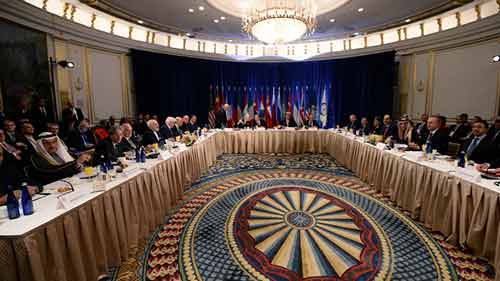Syria’s future following a peace plan
Thursday, 11:06, 24/12/2015
(VOV) - The UN has approved a resolution outlining a ceasefire and peace process in Syria. It was tough to reach a comprehensive agreement to end the 5-year conflict that has killed 250,000 people and forced millions of Syrians to flee their home.
The UN Security Council approved the peace plan for Syria on December 19.
The plan outlines a 2-year roadmap leading to an election to form a new government and a ceasefire agreement scheduled to begin next month.
The UN resolution identifies 3 major parts of a political solution for Syria.
It endorses the 17-nation International Syrian Support Group, ISSG, as the main peace arbitrator for Syria; endorses the peace plan the ISSG adopted in November, including a 6-month ceasefire and talks leading to new constitution; and gives the United Nations a leading role in working with the regime and opposition to negotiate the ceasefire and draft the new constitution.

It is the first time in many years that the US and Russia have shared any agreement at all on Syria. But the resolution does not say who will be the new leader of Syria, the main item of dispute.
The US says Assad must leave, while Russia supports Assad and is conducting military operations in Syria in coordination with Assad’s troops.
The plan outlines a 2-year roadmap leading to an election to form a new government and a ceasefire agreement scheduled to begin next month.
The UN resolution identifies 3 major parts of a political solution for Syria.
It endorses the 17-nation International Syrian Support Group, ISSG, as the main peace arbitrator for Syria; endorses the peace plan the ISSG adopted in November, including a 6-month ceasefire and talks leading to new constitution; and gives the United Nations a leading role in working with the regime and opposition to negotiate the ceasefire and draft the new constitution.
This week’s UN meeting followed a meeting last week in Saudi Arabia at which Syrian opposition groups agreed to unite to negotiate a ceasefire with the current regime.

The US says Assad must leave, while Russia supports Assad and is conducting military operations in Syria in coordination with Assad’s troops.
While Russia and the US focus on military operations against IS, the Syrian people are more concerned about Assad’s fate.
One obstacle to implementing the peace plan is that Syrian opposition groups reject any political solution that will allow Assad to remain in office.
They didn’t attend a recent meeting of foreign ministers from 17 countries and the UN, and they have accused Assad’s government of complicating their struggle with IS.
They didn’t attend a recent meeting of foreign ministers from 17 countries and the UN, and they have accused Assad’s government of complicating their struggle with IS.

